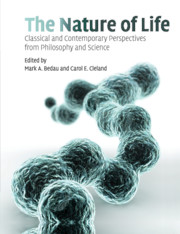Book contents
- Frontmatter
- Contents
- Preface
- Acknowledgments
- Sources
- About the authors
- Introduction
- SECTION I CLASSICAL DISCUSSIONS OF LIFE
- SECTION II THE ORIGIN AND EXTENT OF NATURAL LIFE
- SECTION III ARTIFICIAL LIFE AND SYNTHETIC BIOLOGY
- SECTION IV DEFINING AND EXPLAINING LIFE
- Supplementary bibliography on life
- Index
- References
SECTION III - ARTIFICIAL LIFE AND SYNTHETIC BIOLOGY
Published online by Cambridge University Press: 10 November 2010
- Frontmatter
- Contents
- Preface
- Acknowledgments
- Sources
- About the authors
- Introduction
- SECTION I CLASSICAL DISCUSSIONS OF LIFE
- SECTION II THE ORIGIN AND EXTENT OF NATURAL LIFE
- SECTION III ARTIFICIAL LIFE AND SYNTHETIC BIOLOGY
- SECTION IV DEFINING AND EXPLAINING LIFE
- Supplementary bibliography on life
- Index
- References
Summary
As the discussions in Sections I and II underscore, natural life as we know it on Earth today is an extremely complex phenomenon, having distinctive functional characteristics at the abstract level and comprising specific chemical elements, molecules, and biochemical pathways at the physical level. Its complex, multi-leveled, interconnected character poses problems for biologists trying to generalize to all forms of life: Which features of our only unequivocal example of life are fundamental to all life? Artificial life (also known as “ALife”) is an interdisciplinary study that aims to circumvent this difficulty by artificially synthesizing lifelike processes both in isolation and together at different levels of analysis. This allows researchers to better explore questions such as whether the stuff that comprises life is essential to it. Underlying research in ALife is the view that one of the best ways to understand something is to learn how to make it. The term “artificial” refers to the fact that humans are involved in the construction process, and indicates that the results might be quite unlike natural forms of life. There is a lively debate among ALife researchers over what types of artificial life qualify as genuine examples of life, instead of mere simulations or models of life. The question is, when is a simulation or model of life complete enough to be the real thing?
Artificial life research can be subdivided into three broad categories, reflecting three different types of synthetic methods (Bedau 2003, 2007).
- Type
- Chapter
- Information
- The Nature of LifeClassical and Contemporary Perspectives from Philosophy and Science, pp. 217 - 224Publisher: Cambridge University PressPrint publication year: 2010



